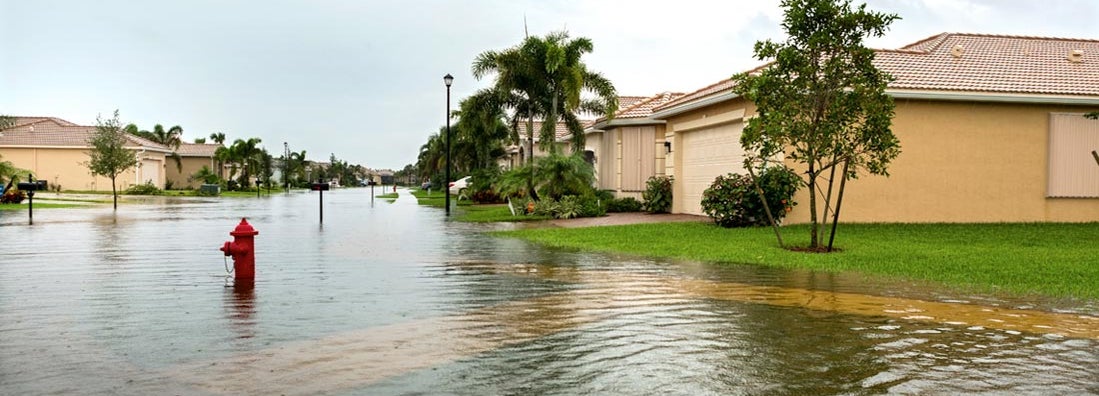Is New Development Changing Your Flood Risk?

Floods are often associated with rivers and streams overrunning their banks, or with heavy rains from hurricanes and other major storms. And while those are very real hazards, flooding can be caused by a number of factors that you might not have considered.
One major contributor to flooding in some areas is new development and construction.
Flooding and New Development
A development project or new construction can drastically alter how the ground in the area is able to absorb water from rain or melting snow, particularly when the ground around the project is cleared of trees and other brush that help absorb ground water. If the project has a large paved area, like a parking lot, alterations to drainage and runoff can lead to flooding.
Even a new home built next to a large development like a shopping center can seriously impact the flood risk for an entire neighborhood.
That means that just because your home hasn’t flooded before, it doesn’t meant that it won’t flood in the future as development changes the topography in your community. Some experts even go so far as to say that everyone lives in a flood zone, it’s just their level of risk that varies.
Flood risk is very dynamic and changes over time due to new weather patterns and construction in and around your community. Your risk today is not the same as it was 50 years ago, and it will certainly be different 50 years in the future.
That’s why it’s so important to understand your flood risk and how it may change due to new land development in and around your home or business. Then you can prepare and protect your property by purchasing flood insurance and undertaking any necessary mitigation actions.
How Can Flood Insurance Help?
Flooding is one of the most financially and emotionally devastating events that can happen to a homeowner or business owner. According to FEMA, just one inch of water in a home can cause more than $25,000 in damage.
Your homeowners insurance policy or a commercial property insurance policy will not provide coverage for damage caused by flooding.
Congress created the National Flood Insurance Program (NFIP) in 1968 to help provide a way for property owners to financially protect themselves from flood damage. Flood insurance from the NFIP is available to homeowners, renters, condo owners, and business owners in communities that participate in the program.
So if your home or business were flooded, how would you make repairs, rebuild, and replace your damaged or destroyed possessions? Without flood insurance, you’d probably have to pay out of pocket or take out a loan.
Even in cases of severe, widespread flooding, a Presidential Disaster Declaration may not provide the financial resources you need to completely rebuild. Federal disaster relief in the form of a US Small Business Administration loan must be paid back with interest. FEMA disaster grants—which do not have to be paid back—are only about $5,000 per household, on average.
That’s why every homeowner or business owner needs to consider purchasing flood insurance. Whether you live in a flood zone now, or construction and development in your area causes sudden changes to your flood risk, purchasing flood insurance is one of the most important things you can do to protect your home or business.
What Kind of Claims Are Covered by Flood Insurance?
Your NFIP flood insurance policy only covers your property damage under certain conditions. The NFIP defines a flood as, “An excess of water on land that is normally dry, affecting two or more acres of land or two or more properties.”
Other examples of flooding as defined by the NFIP include:
- Overflow: During a tropical storm or a hurricane, storm surge can cause an overflow of inland or tidal waters.
- Runoff: When an area without sufficient drainage receives heavy rainfall over a short period.
- Mudflow: Heavy or sustained rainfall accumulates on the ground and forms a river of mud down a hillside. This is a common occurrence after a wildfire.
- Erosion: Severe storms can produce waves and cause shoreline erosion along lakes and other bodies of water.
Again according to the NFIP, “Flood insurance covers overflow of inland or tidal waters and unusual and rapid accumulation or runoff of surface waters from any source. However, the flood must be a general and temporary condition of partial or complete inundation of two or more acres of normally dry land area or of two or more properties (at least one of which is yours).”
These conditions can be created by new construction or development in your community, making your property susceptible to flooding under conditions that previously were not problematic.
What Kinds of Damage Are Covered by Flood Insurance?
Flood insurance covers physical damage to your property and possessions. Building and contents coverage are purchased separately (preferred risk policies offer an option for combination coverage), and have separate deductibles.
Building coverage pays for damage to:
- The building and its foundation
- Electrical and plumbing systems
- Central air conditioning equipment, furnaces, and water heaters
- Refrigerators, stoves, and built-in appliances
- Permanently installed carpeting over unfinished flooring
- Permanently installed paneling, wallboard, bookcases, and cabinets
- Window blinds
- Detached garages
- Debris removal
Contents coverage pays for damage to your belongings:
- Clothing, furniture, and electronics
- Curtains
- Portable and window air conditioners
- Portable appliances (e.g., microwave ovens and dishwashers)
- Carpets that are not included in the building coverage
- Clothes washers and dryers
- Food freezers and the food in them
- Certain valuable items such as original artwork and furs, up to $2,500
Coverage for basements and areas below the lowest elevated floor is limited.
Remember that the cause of the flooding determines whether your flood insurance policy provides coverage. Damage caused by a sewer backup is only covered by flood insurance if it is a direct result of flooding. If the backup is caused by some other problem, the damage is not covered by your flood insurance policy.
Flood insurance policies don’t cover everything. It’s important to understand the coverage exclusions to make sure you are fully prepared.
Here are just a few examples of items excluded from flood insurance coverage:
- Damage caused by moisture, mildew, or mold that could have been avoided by the property owner or which are not caused by a flood
- Temporary living expenses, such as hotel expenses, while the building is being repaired or is uninhabitable
- Loss of income caused by business interruption
- Property and belongings outside of the home or business, such as trees, plants, wells, septic systems, walks, decks, patios, fences, seawalls, hot tubs, and swimming pools
How an Independent Insurance Agent Can Help
Flood insurance can only be purchased from your insurance agent, not directly from the federal government. When you apply for federal flood insurance, there will be a 30-day waiting period after you have completed the application and made the first premium payment for the policy to become effective.
Your independent insurance agent can help you learn about whether you live on a flood plain or in a high-risk zone, and can get you quotes for flood insurance in your community.
https://www.fema.gov/media-library-data/1513200364180-bab79b0ae4855f62ebc94baa06fc0186/Common_Questions_Fact_Sheet.pdf
https://www.floodsmart.gov
